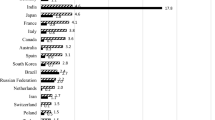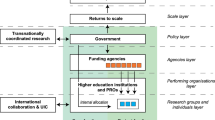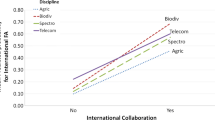Abstract
Bibliometric impact analyses show that Swedish research has less international visibility than Danish research. When taking a global view on all subject fields and selecting publications cited higher than the 90th percentile, i.e., the Top 10 %—publications, the Swedish Research Council shows that although Sweden ranks 15 % above world average, Denmark, the Netherlands and Switzerland rank 35–40 % above. To explain these different performances, The Royal Swedish Academy of Sciences asked us to compare the national research systems on three levels: priority setting at national level, governance of universities and direction and funding of research. There are of course many similarities between the Danish and Swedish research systems but there are still subtle differences that have developed over time, which may explain the different international visibility. First of all, it does not depend on different levels of public spending on research and development. However, the core funding of universities relative external funding is higher in Denmark than in Sweden. The academic leadership of Danish universities in terms of board, vice-chancellor, faculty dean and department chair is also more coherent and focused on priority setting, recruitment, organization and deployment of resources to establish research environments that operate at the forefront of international research. On all these points we see a weaker leadership in Sweden. Furthermore, over the last 20 years, public funding of research in Sweden has become more and more unpredictable and program oriented with many new actors, while the Danish funding system, although it also has developed over time, shows more consistency with strong actors to fund individuals with novel ideas. The research policy in Sweden has also developed multiple, sometimes even conflicting goals, which have undermined conditions for high-impact research, while in Denmark a policy to support excellence in research has been more coherent.
Access this chapter
Tax calculation will be finalised at checkout
Purchases are for personal use only
Similar content being viewed by others
References
Aagaard K, Mejlgaard N (2012) Dansk forskningspolitikk efter årtusindskiftet. Aarhus universitetsforlag, Aarhus
Aksnes D, Benner M, Brorstad Borlaug S, Foss Hansen H, Kallerud E, Kristiansen E, Langfeldt L, Pelkonen A, Sivertsen G (2013) Centres of excellence in the Nordic countries. A comparative study of research excellence policy and excellence centre schemes in Denmark, Finland, Norway and Sweden. NIFU, Oslo
Andersen JE (2011) Academic staff in Denmark: The consequences of massification in a small country. In: Enders J (ed) Academic staff in Europe. Changing contexts and conditions. Greenwood Press, London, pp 49–66
Benner M (2001) Kontrovers och konsensus. Nya Doxa, Nora
Benner M (2008) Kunskapsnation i kris? Nya Doxa, Nora
Benner M, Öquist G (2014) Room for increased ambitions? Governing breakthrough research in Norway 1990-2013. The Research Council of Norway. http://www.forskningsradet.no/publikasjoner. Accessed 5 Mar 2014
Engwall L (2014) The recruitment of university top leaders: politics, communities and markets in interaction. Scand J Manag 30:332–343
Engwall L, Lindwall Eriksson K (2012) Leaders of modern universities: Primi inter pares of chief executive officers? In: Tengblad S (ed) The work of managers. Oxford University Press, Oxford, pp 206–225
Esping-Andersen G (1990) The three worlds of welfare capitalism. Polity, Cambridge
Evaluation of the Danish National Research Foundation (2013) Danish agency for science, technology and innovation. http://www.fivu.dk. Accessed 5 Mar 2014
Goodall A (2006) Should top universities be led by top researchers, and are they? A citations analysis. J Doc 62:388–411
Goodall A (2009) Highly cited leaders and the performance of research universities. Res Policy 28(7):1078–1092
Goodall AH, McDowell JM, Singell LD (2014) Leadership and the research productivity of university departments. IZA Working Paper No. 7903
Hedström P, Swedberg R (eds) (1998) Social mechanisms. An analytical approach to social theory. Cambridge University Press, Cambridge
Hyman R (1995) Industrial relations in Europe: theory and practice’. Eur J Indus Relat 1(1):17–46
Karlsson S, Persson O (2012) The Swedish production of highly cited papers. Vetenskapsrådets lilla rapportserie 5:2012. The Swedish Research Council
Karlsson S, Persson O (2014) The production of highly cited papers. Vetenskpsrådets lilla rapportserie 5:2012 updated to include Norway. In: Benner M, Öquist G (2014) Room for increased ambitions? Governing breakthrough research in Norway 1990-2013. The Research Council of Norway. http://www.forskningsradet.no/publikasjoner. Accessed 5 Mar 2014
NordForsk (2011) Bibliometric research performance indicators for the Nordic countries. Nordforsk, Oslo. http://nordforsk.org. Accessed 5 Mar 2014
NordForsk (2014) Comparing research at Nordic universities using bibliometric indicators. Nordforsk, Oslo. http://nordforsk.org. Accessed 5 Mar 2014
Olesen Larsen P (2010) Stages on the research road: Danish research policy, past and present. Syddansk universitetsforlag, Odense
Öquist G, Benner M (2012) Fostering breakthrough research: a comparative study. Akademirapport, Royal Swedish Academy of Sciences
Schwaag Serger S, Bienestock A, Benner M, Lidgard A (2014) Combining excellence in education, research and impact: Inspiration from Stanford and Berkeley and implications for Swedish universities. SNS, Stockholm
Sundqvist B (2010) Svenska universitet: lärdomsborgar eller politiska instrument? Gidlund, Hedemora
Swedish Government (2012/2013) Forskning och innovation. http://www.regeringen.se/sb/d/15650/a/201368. Accessed 5 Mar 2014
The Aarhus Declaration (2012) http://www.excellence2012.dk/the-aarhus-declaration/. Accessed 5 Mar 2014
Törnqvist G (2009) Kreativitet i tid och rum: processer, personer och platser. SNS, Stockholm
Author information
Authors and Affiliations
Corresponding author
Editor information
Editors and Affiliations
Rights and permissions
Copyright information
© 2015 Springer International Publishing Switzerland
About this chapter
Cite this chapter
Öquist, G., Benner, M. (2015). Why Are Some Nations More Successful Than Others in Research Impact? A Comparison Between Denmark and Sweden. In: Welpe, I., Wollersheim, J., Ringelhan, S., Osterloh, M. (eds) Incentives and Performance. Springer, Cham. https://doi.org/10.1007/978-3-319-09785-5_15
Download citation
DOI: https://doi.org/10.1007/978-3-319-09785-5_15
Published:
Publisher Name: Springer, Cham
Print ISBN: 978-3-319-09784-8
Online ISBN: 978-3-319-09785-5
eBook Packages: Business and EconomicsBusiness and Management (R0)




